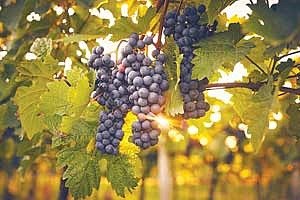
Wine through the ages...
There are around 60 species of vine but only one bears the fruit which when fermented produces wine.Evidence of grape pips at Palaeolithic sites indicates humans were eating grapes from around 7000BC. The first vineyard dates from 3200 BC when the Egyptians and Phoenicians began planting and tending vines.
At first grapes were grown only for eating. It is likely that wine was an accidental discovery. It would only have taken a few hours in full sun for ripe juicy grapes to begin fermenting (the process by which natural sugars are turned into alcohol) aided by the natural yeasts present in the ‘bloom’ on the fruit. Before long wine was being made throughout the Mediterranean.
Ancient methods of viticulture (wine-making) bear a lot of similarities to those still in use today. In Egypt grapes were collected in wicker baskets then trodden in huge wooden vats to get the fermentation process started. Once crushed the grapes, juice and skins were poured into loosely corked earthenware jars and left to finish the fermentation process. Finally the mixture was filtered, flavoured and poured into sealed amphorae.
We would be horrified now at what passed for wine in earlier ages. Makers preserved their wines with additions such as heavily sweetened date juice, honey and spices, and even pepper.
By the Middle Ages people tended to prefer full-bodied fortified wines (more akin to our sherries and ports) which were stored in wooden casks.
Over the course of the centuries wine-making evolved. Makers learned that vines grown on the thinner mountain soils seemed to produce superior wines to those grown on the plains.
All the European vines originated from the same species. This made them vulnerable to pests and diseases (a problem affecting banana producers nowadays). A highly destructive aphid called the grape phylloxera reached Europe at the beginning of the 20th century and wiped out almost all of the Old World vines in just a few years.
Fortunately scientists stepped in and managed to develop healthy plants by grafting European varieties on to American rootstock, because the American vines were resistant to the aphid. This helped the Americans too because their native vines produced inferior wine. All of today’s Chardonnay and Cabernet Sauvignon wines are produced from ‘rescued’ vines!
There are now a huge variety of grapes for manufacturers to choose from and this, coupled with modern wine-making techniques have made wines more standardised and reliable. But recently there has been a move back to artisan wine-making by passionate manufacturers who want more individuality, uniqueness or ‘terroir’. Truth is there has never been a better time to be a wine-drinker. Cheers!
By Tracey Anderson

